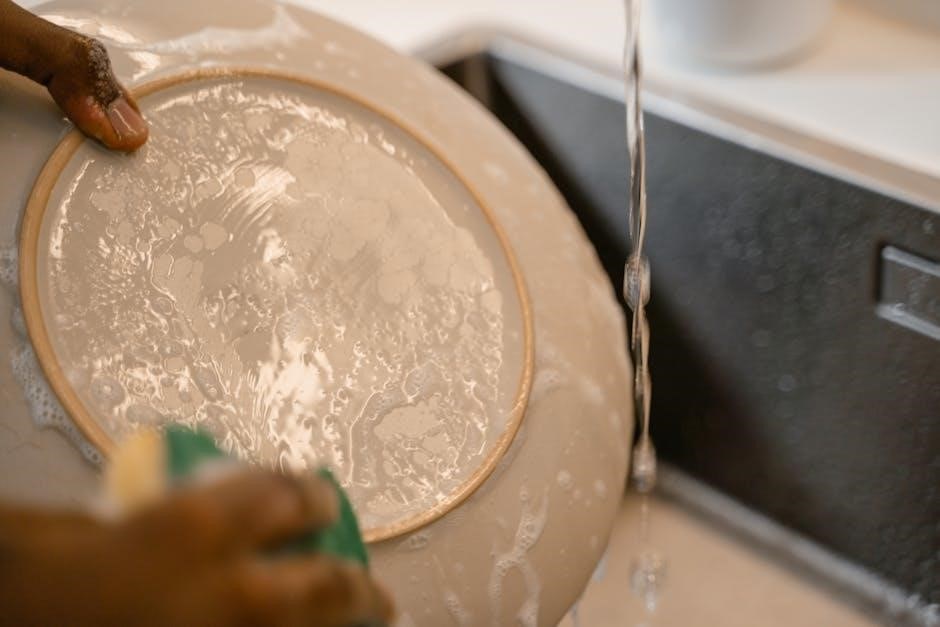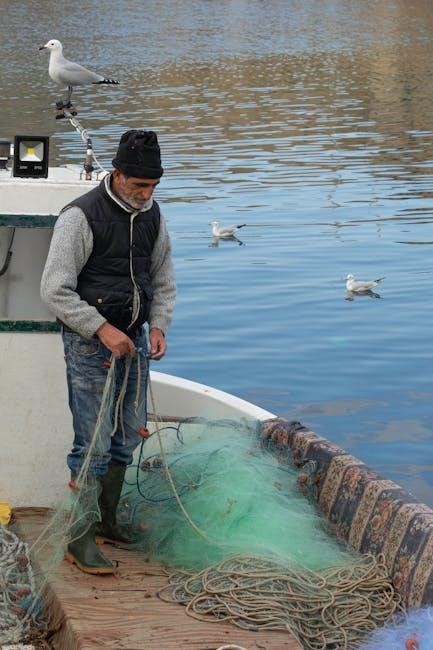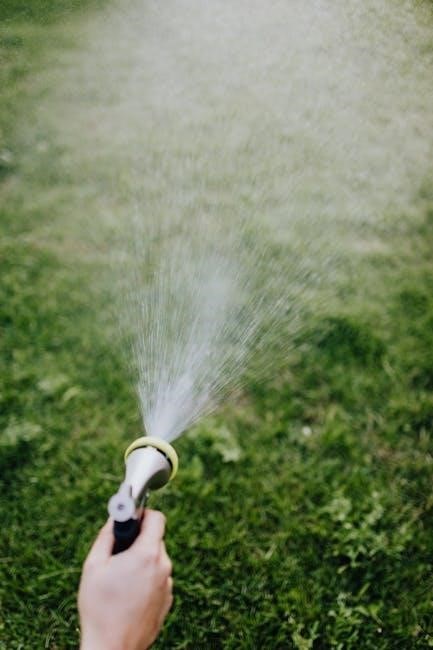Clack Corporation offers high-quality water softeners known for their efficiency and durability, providing innovative solutions for improving water quality in residential and commercial settings.
1.1 History and Overview of Clack Corporation
Clack Corporation, established in 1946, specializes in water treatment solutions, offering high-quality products like control valves and water softeners. Known for innovation, they provide reliable systems for residential and commercial use, ensuring improved water quality and efficiency. Their products, such as the WS1 series, are renowned for durability and advanced features, making them a trusted name in the industry. Clack Corporation remains committed to delivering superior water treatment solutions, focusing on customer satisfaction and environmental sustainability.
1.2 Key Features of Clack Water Softeners
Clack water softeners are renowned for their advanced control valves, customizable settings, and high-efficiency systems. The WS1 series, for instance, offers smart technology integration, allowing users to monitor and adjust settings effortlessly. These systems feature manual regeneration options, smart sensors, and adaptive learning capabilities to optimize water usage. With a focus on durability and performance, Clack water softeners are designed to minimize salt consumption and reduce environmental impact. Their modular design ensures compatibility with various filtration systems, making them a versatile choice for diverse water treatment needs.
1.3 Benefits of Using Clack Water Softeners
Clack water softeners provide numerous benefits, including reduced mineral buildup in pipes and appliances, softer skin and hair, and improved water quality. They minimize scaling, extending the lifespan of plumbing and fixtures. Energy efficiency is enhanced, lowering utility bills. The systems are eco-friendly, using less salt and water during regeneration. Clack softeners also improve the taste and odor of water, making it ideal for drinking and cooking. Their advanced technology ensures consistent performance, while compatibility with additional filtration systems offers comprehensive water treatment solutions for homes and businesses.
Installation Guide
The Clack water softener manual provides a detailed installation guide, ensuring proper setup and compliance with local plumbing codes for safe and efficient operation.
2.1 System Requirements and Pre-Installation Checks
Before installing a Clack water softener, ensure the system meets electrical and plumbing requirements. Check water pressure, inlet/outlet sizes, and drain line compatibility. Ensure the distance between the drain and filter is minimal, and at least 10 feet of piping separates the softener outlet from the water heater inlet. Verify local plumbing codes and install a bypass valve if needed. Conduct a leak test and ensure the power supply is stable. Proper pre-installation checks ensure smooth operation and compliance with safety standards.
2.2 Step-by-Step Installation Process

Begin by connecting the inlet and outlet pipes to the water softener, ensuring proper sizing and alignment. Next, install the drain line, keeping it as short as possible and adhering to local plumbing codes. If required, attach the bypass valve to bypass water flow during regeneration. Connect the electrical supply to the control valve, following the manufacturer’s wiring diagram. Finally, program the control valve with the correct time and settings, then initiate a manual regeneration cycle to test the system. Ensure all connections are secure and leak-free before normal operation.
2.3 Plumbing Considerations and Local Codes
Ensure all plumbing connections comply with local codes and regulations. Keep the drain line as short as possible and avoid installing any water filter within 10 feet of a water heater inlet. Use appropriately sized pipes to maintain water flow efficiency. Check for leaks after installation and ensure all fittings are secure. Adhere to local plumbing standards for backflow prevention and drainage. Properly insulate pipes in areas prone to freezing. Always consult local authorities for specific requirements before starting the installation process.

Operating Instructions
Monitor daily operation, initiate manual regeneration if needed, and understand display indicators for smooth functionality. Regular checks ensure optimal performance and address any issues promptly.
3.1 Daily Operation and Monitoring
Daily operation involves monitoring the system’s performance, ensuring it softens water effectively. Check the display regularly for indicators like C1, C2, which show regeneration phases. The system automatically tracks water usage and schedules regeneration based on demand. Users can toggle between the time of day and gallons remaining until the next cycle using the NEXT button. Manual regeneration can be initiated by pressing and holding the REGEN button for 3 seconds. Regular monitoring helps maintain optimal water quality and system efficiency, addressing any issues before they escalate.
3.2 Manual Regeneration Process
To initiate manual regeneration on a Clack water softener, press and hold the REGEN button for 3 seconds. The system will immediately start the regeneration cycle, displaying indicators like C1, C2, etc., to show progress. During this process, the softener performs backwash, rinse, and refill phases to replenish resin. Manual regeneration is useful for addressing specific water quality issues or preparing for high water demand. After completion, the system returns to normal operation, ensuring softened water is available for use. This feature provides flexibility for users to control regeneration outside the automatic schedule.
3.3 Understanding the Display and Indicators
The Clack water softener’s display provides essential information for monitoring system operation. During regeneration, indicators like C1, C2 appear to show cycle progress. The display toggles between the time of day and gallons until next regeneration in standard mode. When water is being treated, TODAY is displayed. These indicators help users track system status, ensuring optimal performance and timely maintenance. Understanding the display enables users to monitor operations effectively and address any issues promptly, ensuring consistent access to softened water.

Maintenance and Upkeep

Regular maintenance ensures optimal performance of Clack water softeners. Tasks include checking salt levels, cleaning the brine tank, and replacing filters as needed for consistent water quality.
4.1 Regular Maintenance Tasks
Regular maintenance is crucial for optimal performance of Clack water softeners. Key tasks include checking salt levels, cleaning the brine tank, and replacing filters as recommended. Ensure the system is free from debris and sediment buildup. After new installation or media changes, run two regenerations to fully charge the media. Refer to the manual for specific guidance on these procedures to maintain water quality and system longevity.
4.2 Replacing Parts and Filters
Replacing parts and filters in Clack water softeners is essential for maintaining performance. Regularly inspect and replace the resin, control valve, and drain lines as needed. Ensure the brine tank is clean and free from debris. Refer to the manual for specific replacement intervals and procedures. Always use genuine Clack parts to guarantee compatibility and efficiency. Proper replacement ensures optimal water quality and prevents system malfunctions. Follow safety guidelines and local plumbing codes when performing replacements to maintain warranty validity and system longevity.
4.3 Tips for Optimal Performance
For optimal performance, regularly monitor and maintain your Clack water softener. Schedule manual regeneration when needed and ensure proper salt levels in the brine tank. Check for any blockages in the drain line and clean the venturi valve periodically. Maintain the resin bed by avoiding excessive backwash cycles. Keep the system free from debris and ensure all connections are secure. Adhere to the recommended maintenance schedule outlined in the manual. Proper care extends the lifespan and ensures consistent water quality. Regularly test water hardness to confirm the system is functioning effectively.
Troubleshooting Common Issues

Identify and resolve issues like error codes (C1, C2) by checking the drain line, cleaning the venturi valve, and ensuring proper system regeneration. Monitor water quality regularly.
5.1 Identifying Common Problems
Common issues with Clack water softeners include error codes (C1, C2), display malfunctions, or regeneration cycle problems. These can often be identified through the control valve’s display messages or unusual system behavior. For example, if the display shows an error code, it may indicate a specific issue like a faulty sensor or valve malfunction. Additionally, issues during regeneration, such as incomplete cycles or excessive water usage, can signal problems with the system’s programming or components. Regular monitoring and understanding these indicators can help in addressing issues promptly, ensuring optimal performance and water quality.
5.2 Error Codes and Solutions
Clack water softeners display error codes like C1, C2, or others to indicate specific issues. For example, C1 may signal a communication error, while C2 could indicate a valve malfunction; Solutions often involve checking wire connections, cleaning sensors, or restarting the system. Referencing the manual or manufacturer guidelines is essential for accurate troubleshooting. If issues persist, contacting a professional is recommended to ensure proper resolution and maintain system efficiency. Addressing error codes promptly helps prevent further complications and ensures consistent water quality.
5.3 DIY Fixes and When to Call a Professional
For minor issues like error codes or system lockouts, DIY fixes such as resetting the control valve or cleaning sensors can resolve the problem. However, complex issues like valve malfunctions or electrical faults require professional expertise. If DIY steps fail or you encounter advanced errors, contacting a certified technician is recommended to avoid further damage. Always prioritize safety and system integrity by seeking professional help when dealing with intricate repairs or unfamiliar situations. This ensures optimal performance and longevity of your Clack water softener system.
Programming the Control Valve
Programming the control valve involves setting time, adjusting regeneration cycles, and customizing settings to optimize water softening performance based on specific water usage and treatment needs.
6.1 Setting the Time and Basic Parameters

To set the time and basic parameters on your Clack water softener, press the NEXT button to toggle between the time of day and gallons before regeneration. Use the REGEN button to adjust values. The system defaults to a 14-day regeneration cycle but can be set to 7 or 28 days. For manual regeneration, hold the REGEN button for 3 seconds. The display will show C1, C2 during cycles. Ensure the time is accurate for proper operation. Refer to the manual for detailed instructions on customizing settings to match your water usage needs.
6.2 Adjusting Regeneration Settings
Adjusting regeneration settings on your Clack water softener allows customization to meet specific water usage needs. The default regeneration cycle is set to occur every 14 days but can be adjusted to 7 or 28 days. To modify, press and hold the REGEN button for 3 seconds to initiate manual regeneration. The system will display C1, C2 during cycles. Ensure the time is correctly set before adjusting regeneration parameters. Refer to the manual for detailed steps on customizing regeneration frequency and ensuring optimal performance based on your household’s water demand.
6.3 Custom Programming Options
The Clack water softener allows advanced customization to suit specific needs. Users can program regeneration cycles from 7 to 28 days or disable regeneration entirely. The system also supports custom settings for water hardness levels and flow rates. For enhanced control, the MAV (Multi-Port Valve) connector enables no-hard-water bypass operation. Custom programming ensures efficient water treatment tailored to individual preferences. Refer to the manual for detailed steps on adjusting these settings to optimize performance and water quality based on your unique requirements.

Understanding Regeneration Cycles
Regeneration cycles refresh the system by removing accumulated impurities. The process includes backwash, rinse, and refill phases, ensuring optimal performance. The display shows indicators like C1 or C2 during cycles.
7.1 Types of Regeneration Cycles
Clack water softeners feature three primary regeneration cycles: softener, regenerative filter, and backwashing filter. The softener cycle includes backwash, rinse, and refill phases, ensuring impurities are removed. Regenerative filters backwash and refill after rinsing, while backwashing filters only backwash. Each cycle is indicated on the display (e.g., C1, C2) and is essential for maintaining system efficiency. Manual regeneration can be initiated for immediate refresh, ensuring optimal water quality and system performance.
7.2 How Regeneration Works
Regeneration in Clack water softeners involves a series of cycles to remove impurities and replenish the system. The process includes backwash, rinse, and refill phases. During backwash, water flows reverse to clean the resin or filter media. The rinse phase ensures remaining impurities are flushed out, and refill replenishes the system with fresh water or salt. The display shows indicators like C1 or C2 during these cycles. Manual regeneration can be triggered by holding the REGEN button for three seconds, allowing users to refresh the system as needed for optimal performance.
7.3 Initiating Manual Regeneration
To initiate manual regeneration on a Clack water softener, press and hold the REGEN button for three seconds. The system will immediately start the regeneration cycle, which includes backwash, rinse, and refill phases. During this process, the display will show indicators like C1, C2, etc., representing the current phase. Manual regeneration ensures the system is refreshed and ready for optimal performance. This feature is useful for immediate maintenance or when the automatic schedule isn’t sufficient. The process is straightforward and ensures the water softener operates efficiently at all times.

Water Quality and Filtration
Clack water softeners effectively address common issues like hard water, iron, and manganese, utilizing advanced filtration technology to improve water quality and ensure cleaner, safer drinking water.
8.1 Common Water Quality Issues Addressed
Clack water softeners effectively tackle hard water, iron, and manganese, improving water quality. They utilize advanced filtration to remove impurities, reducing scaling and staining. The systems also address dissolved iron and manganese through catalytic oxidation, trapping particles in the filter media. This ensures cleaner water for drinking, cooking, and household use, while protecting appliances from damage. Regular regeneration cycles maintain optimal performance, keeping water soft and free from contaminants. These solutions are designed to enhance water quality and provide long-term benefits for residential and commercial applications.
8.2 Filtration Media and Technology
Clack water softeners employ advanced filtration media, including catalytic technology, to effectively remove impurities like iron and manganese. The systems utilize high-quality ion exchange resins to eliminate water hardness. The filtration process involves multiple cycles, such as backwash and rinse, to ensure optimal performance. Advanced control valves regulate water flow and regeneration, enhancing efficiency. These technologies work together to provide clean, softened water while minimizing maintenance. The combination of robust media and intelligent systems ensures reliable operation and superior water quality for both residential and commercial applications.
8.3 Monitoring Water Quality Post-Installation
After installing a Clack water softener, regular monitoring ensures optimal performance. Check for hardness, iron, and manganese levels to confirm effective filtration. The system’s display provides real-time data on water usage and regeneration cycles. Run manual regenerations if necessary and test water samples periodically. Ensure the backwash cycle runs clear to confirm proper filtration. Regular maintenance, like replacing filters, is crucial for sustained water quality. Refer to the manual for specific guidelines on monitoring and adjusting settings to maintain clean, softened water consistently.
Advanced Features and Customization
Clack water softeners offer advanced features like smart technology integration, custom settings, and additional filtration options for tailored water treatment solutions, enhancing performance and user convenience.

9.1 Custom Settings for Specific Needs
Clack water softeners allow users to customize settings to address specific water quality issues, such as iron levels or hardness. The control valve can be programmed to adjust regeneration cycles, backwash intervals, and flow rates based on household needs. For instance, users can set regeneration to occur at off-peak hours or adjust the volume of water treated before regeneration. Additionally, the system supports custom settings for iron filtration, ensuring tailored solutions for varying water conditions. These features enhance efficiency and provide optimal water treatment for diverse household requirements, as detailed in the manual.
9.2 Smart Technology Integration
Clack water softeners integrate smart technology for enhanced functionality and convenience. The system allows remote monitoring and adjustments via a smartphone app, enabling users to track water usage and receive notifications for maintenance. Smart sensors detect water quality changes and automatically adjust settings for optimal performance. Additionally, the system can integrate with smart home systems, offering voice control through platforms like Alexa. This advanced technology ensures efficient water treatment, reduces waste, and provides real-time insights, making it a modern solution for managing water quality effectively. The manual details how to set up and utilize these smart features.
9.3 Additional Filtration Options
Clack water softeners can be paired with additional filtration systems to address specific water quality issues. For iron and manganese removal, catalytic media is integrated to oxidize and trap these minerals. The system also supports UV filtration for bacteria and viruses, ensuring safer drinking water. Sediment filters can be added to remove particulate matter, while reverse osmosis systems further reduce dissolved solids; These options enhance the overall water treatment process, providing tailored solutions for various water quality concerns. The manual details how to integrate and maintain these additional filtration components effectively.
Safety Precautions and Warranties
Clack water softeners adhere to safety standards, ensuring compliance with NSF and WQA certifications. Proper installation and use are emphasized to avoid hazards. Warranty details are provided for coverage and support, ensuring optimal performance and user protection.
10.1 Safety Guidelines for Installation and Use
Ensure all installations comply with local plumbing codes and safety standards. Keep the distance between the drain and water filter short to prevent contamination. Avoid installing filters with less than 10 feet of piping before a water heater. Properly ground electrical connections to prevent shocks. Follow the manufacturer’s instructions for start-up procedures to minimize risks. Regularly inspect and maintain the system to ensure safe operation. Adhere to NSF and WQA certifications for compliance with safety and performance standards. Always turn off the water supply before performing maintenance or repairs.
10.2 Warranty Information and Support
Clack Corporation offers comprehensive warranties for their water softeners, ensuring coverage for parts and labor under specified conditions. Dedicated customer support teams are available to address inquiries and provide assistance. Online resources, including manuals and troubleshooting guides, are accessible for user convenience. Warranty details can be verified through NSF and WQA certifications. For optimal support, register your product with Clack Corporation. This ensures timely assistance and maintains warranty validity, providing peace of mind and prolonging system performance.
10.3 Compliance with Safety Standards
Clack Corporation water softeners comply with rigorous safety standards, ensuring reliable and safe operation. Certified by NSF and WQA, these systems meet strict testing criteria for material quality and performance. Compliance with local plumbing codes and environmental regulations is prioritized, guaranteeing safe installation and use. The designs adhere to industry standards, minimizing risks and ensuring durability. Regular audits and third-party testing further validate their commitment to safety and quality, providing users with confidence in their water treatment solutions.
Clack Corporation water softeners offer reliable solutions for improving water quality. For further assistance, refer to the official manuals, guides, and support resources available on their website.
11.1 Summary of Key Points
Clack Corporation water softeners are renowned for their efficient design and advanced technology, addressing hard water issues effectively. Proper installation, regular maintenance, and understanding regeneration cycles are crucial for optimal performance. Troubleshooting common problems and utilizing customization options enhance user experience. The manuals provide detailed guidance, ensuring longevity and efficiency. By following the outlined steps and leveraging available resources, users can maximize the benefits of their Clack water softener, ensuring clean and softened water consistently.
11.2 Where to Find Further Assistance
For additional support, visit the official Clack Corporation website or refer to the Clack WS1 Water Softener Manual available for download. Pentair’s resources, including the 460i Electronic Demand System manual, also provide valuable insights. Contact Clack’s customer support or authorized dealers for personalized assistance. Online forums and water treatment professionals can offer tailored solutions. Ensure to consult certified experts for complex issues to maintain system performance and warranty compliance. Always verify information through trusted sources to ensure accuracy and reliability.
11.3 Staying Updated with Clack Corporation
To stay informed about Clack Corporation’s latest products and updates, visit their official website or download the Clack WS1 Water Softener Manual. Subscribe to their YouTube channel for instructional videos and updates. For troubleshooting, refer to the Pentair 460i Electronic Demand System manual. Regularly check their support page for new resources and FAQs. Contact Clack’s customer service for personalized assistance. Stay connected with water treatment professionals and online forums for shared experiences and tips. Keeping updated ensures optimal performance and compliance with the latest advancements in water softening technology.